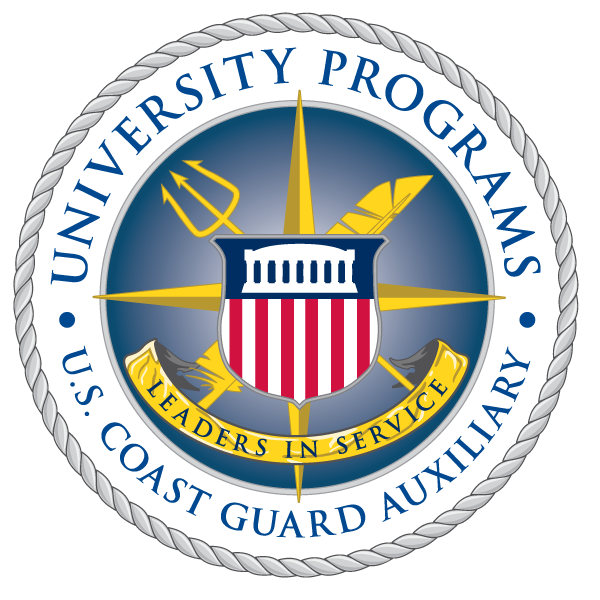Unit William and Mary summer activities: AUP students tackle challenges around the world
Written by Jonathan Roth
A number of Auxiliary University Programs Unit William and Mary students participated in formal internships and Coast Guard operational activities throughout the country this past summer. From the nearby waters of Hampton Roads to Chicago, Brazil, and even a planet 57 million miles away from Earth, their activities were as diverse as the locations in which they took place.
Robert “Seb” Meekins, Communication Services Officer for Flotilla 67 in Williamsburg, Va., went underway as a trainee on July 4th for safety zone support of a fireworks display in Portsmouth, Va. Just as the spectacle began, a report came in of a boat operating without navigation lights in heavily-trafficked area. Seb and the Flotilla 51 crew, based out of Virginia Beach, Va., found the vessel after a quick search, received word that the boat was disabled, and proceed to take it in side tow to another boat. Throughout the rest of the summer, Seb completed Vessel Safety Checks to receive his Vessel Examiner qualification and taught a boating safety course in Virginia Beach.
To the north, Ben Silliman completed an internship at Coast Guard Headquarters in Washington, D.C. Owing to his concentration in chemistry, Ben was paired with the Office of Marine Environmental Response Policy to research and guide policy on responding to spilled oil sands products. The majority of these products entering the United States are Canadian bitumen from Alberta, Canada, which presents unprecedented challenges in case of an oil spill. Ben worked alongside Coast Guard officers and gave formal presentations to pertinent stakeholders on oil sands chemical characteristics and the environmental threats they hold. With his information, Coast Guardsmen responding to these types of spills will be more efficient and lessen the extent of environmental damage. He even briefly met Adm. Papp, Commandant of the Coast Guard. This coming May, Silliman will present his findings to the 2014 International Oil Spill Conference in Savannah, Ga. Silliman received the Auxiliary Commandant’s Letter of Commendation for his work.
To the west, Jonathan Roth was a Coast Guard intern with Ninth District Public Affairs in Chicago. Working with a Chief Petty Officer, Roth assisted in the production, editing and distribution of a public safety announcement featuring an NFL athlete. The video was posted to the uscg.mil homepage during the summer. Additionally, Jonathan wrote a feature article for the Coast Guard Great Lakes blog about the modern-day Coast Guard’s first major rescue operation, the response to the capsizing of the SS Eastland in the Chicago River on July 24, 1915. Jonathan also participated in the “Week in the life of the Coast Guard” public affairs campaign and had his photos featured on the Coast Guard Compass blog, with additional photos of the Tall Ships Challenge Chicago event receiving coverage during a Coast Guard interview on The Weather Channel. Jonathan completed the Public Affairs Specialist I qualification and received the Coast Guard Auxiliary Achievement Medal for his work.
Daniel Sieh worked towards receiving his Coast Guard interpreter qualification in Portuguese this summer. Soon after receiving this qualification, he received a call in the middle of the night from Coast Guard Sector St. Petersburg, which had been contacted by the Brazilian Navy. The Brazilian Navy was monitoring a situation of lost communications aboard a commercial vessel and requested the Coast Guard’s assistance. Daniel served as a vital link between the two organizations and successfully executed the mission to a safe resolution.
On the outskirts of D.C., Ariel Deutsch worked as a NASA intern at Johns Hopkins University Applied Physics Laboratory in Laurel, Md. She worked in the MESSENGER Science Operations Center, which is responsible for the spacecraft currently orbiting Mercury. MESSENGER is retrieving the first data sets of full global coverage for the planet. Deutsch, a geology major at the College, examined evidence for water ice on Mercury using data from the Mercury Dual Imaging System - the camera gimbaled on the spacecraft. Craters on Mercury's North Pole were investigated because of the presence of intriguing radar bright material that had the same spectral signature returned by water ice. Deutsch worked on finding relationships between regions with radar bright and reflectivity dark material and areas of permanent shadow. She will continue to expand on this work while mapping Mercury's North Pole during this academic year for her senior Honors Thesis.
